Other Horror titles ain’t got nothing on this
Since 2017 marks Night Trap‘s 25th anniversary, I took the time to write a little review about the game. For the purposes of this, I am using a European Sega Mega-CD copy that I got off of the internet.
Historical Context
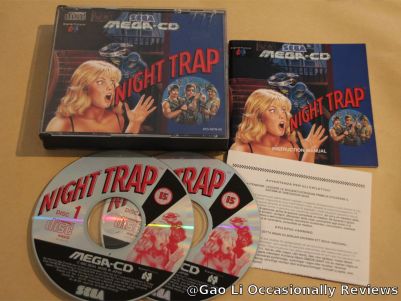
In the late 1970s, early 1980s, when most video games could only rely on pixel art, with favorites such as Pac-Man (1980) or Super Mario Bros. (1985), a new data format called the LaserDisc hit store shelves in East and Southeast Asia, North America, as well as Europe, promising new ways of storing or viewing data. This precursor to the Blu-ray disc commonly had a 30 cm (≈ 12 inch) diameter, weighed about 250 g (≈ ½ pound) and could hold 60 to 64 minutes per side1 (I was told it was an analog storing device and thus didn’t use megabyte). Video game developers couldn’t wait to get their hands on this new tech and created such arcade hits as Dragon’s Lair (1983), Time Gal (1985), or Road Blaster (1985) that were more akin to interactive cartoons than video games and were often even drawn by industry veterans such as the former Disney animator Don Bluth.
Unfortunately, these discs were quite unwieldy and the LaserDisc players rather expensive with an initial price tag of as much as $ 1000 USD upon release, leading up to about $500 USD by 19902. Even worse, manufacturers did not allow users to record their own footage, which its competitor, the Video Home System, or VHS tape, did3. This resulted in the format never catching on and ultimately being completely forgotten. From a video game perspective this then meant that games such as those mentioned above, could only be enjoyed at arcades, but never at the comfort of one’s home. At least that would have been the case, had it not been for the invention of the Compact Disc, or CD, which hit the markets in the 1980s and revolutionized how audiences would consume any medium.

This is because, unlike its precursor, the CD was only 12 cm (≈ 4.7 inch) in diameter, weighed about 15 g (≈ ½ ounce), could store around 700 MB worth of data, and users could record their own footage, provided they owned a CD-burner. Companies couldn’t wait to get their hands on this tech and so several CD-based home entertainment systems like the Philips CD-i (1991), Amiga CD32 (1993), as well the Sony PlayStation (1994) swarmed the market with polygonal titles such as Tomb Raider (1996), Alone in the Dark (1992), or Final Fantasy VII (1997) changing the way video games were viewed by the early 21st century.
What’s more, the above mentioned cartoon games could finally be played at home with Time Gal or Road Blaster, for example, being ported to the Sega Mega-CD/Sega CD (1991) in 1992. But that was not all. Thanks to the massive amount of storage space on CDs, developers could finally experiment to try to blend actual motion pictures together with video games, giving us such titles as The 7th Guest (1993), Wing Commander (1994), as well as (Tex Murphy) Under a Killing Moon (1994). However, very few of these became as notorious as the one celebrating its 25th anniversary in 2017:

Night trap (1992) is, besides Mortal Kombat (1992), the one game responsible for the creation of the American Entertainment Software Rating Board, or ESRB age rating system.4 5
Previously, video games were just assumed to always be child friendly, but Night Trap was different. This game has its roots in slasher movies by the likes of Friday the 13th (1980) and A Nightmare on Elm Street (1984) and a plot revolving around “five […] unattached, beautiful females between the ages of 16 and 19, […]”6 having a slumber party at the old winery house owned by Mr. and Mrs. Victor Martin, who live there with Jeff and Sarah Martin, their two children, and Tony, their cousin. Players are to take on the role of a nameless secret agent working for the SEGA Control Attack Team, or SCAT, mission 230 and control the house’s security cameras as well as its hidden traps. At any point they can freely switch between the eight different rooms and have to activate a trap whenever the auger, vampiric monsters created by the Martins, are either near a trap or threaten to kill one of the girls. This, however, proves to be more than what most players will have bargained for and is the game’s biggest problem.
Gameplay
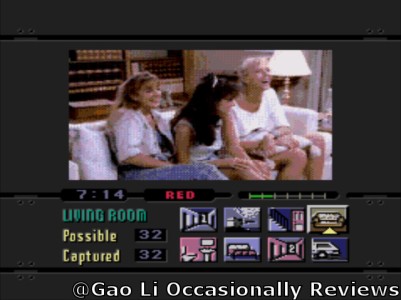
Similar to many other full motion video games (FMV), Night Trap struggles to blend gameplay and movie together. The production is barely interactive as everything had to be filmed before turning it into a game. The players are therefore merely limited to observing different rooms by highlighting them in the menu with the d-pad and selecting them by pressing A on their controller. When an auger then happens to be inside a room and an on-screen bar flashes red, they can activate a trap by pressing B to catch them. In fact, they have to get as many of them as possible, as the game over screen will appear when too many of them have been missed.
From here on out, a major issue with Night Trap makes itself felt: Players can essentially either opt to watch the plot and miss the augers, which might quickly lead to a game over screen, or play the game and try to find these monsters in the other rooms, which means they’ll miss the story. They cannot do both at the same time.
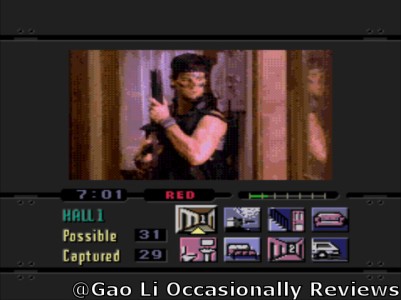
For example, from the very moment the game starts and while the commanding officer of the SCAT operation, Simms, is still explaining the premise and the mission, the first augers appear in the house’s hallway and need to be killed off. From there on out, another group of monsters will appear in a different room every couple of seconds. Even more so, multiple cutscenes will take place simultaneously in different areas of the house. This means that players are expected to play this game several times, to be able to watch all story segments, while they memorize when and where augers will appear. To make things even more complicated, members of the Martin family will occasionally talk about changing the color code of the traps, which means that if the players miss one of these crucial conversations, they won’t be able to use the traps against the augers. The code itself can be one of six colors – blue, green, red, yellow, purple, as well as orange – that players can switch between by repeatedly pressing the C-button on their joypad. It is, of course, possible to just guess which color was randomly selected, or to simply go by progress of elimination. However, since the colors will change more than once during a playthrough, and given that as many augers as possible need to be caught, things can become somewhat stressful rather quickly.
Controversy

While none of what was mentioned so far (and certainly not the story) sounds controversial by today’s video game standards (and was even common practice in 1980s horror movies), the fact that Night Trap was a video game with live actors, caught the attention of the U.S. government. The feeling was that the game’s depiction of violence was too real, that it crossed a line. And so, during a public hearing on December 9th, 19934 5, several people, like U.S. Sen. Herbert Kohl, U.S. Sen. Joseph Lieberman, as well as Eugene Provenzo Jr. of the University of Miami and author of Video Kids: Making Sense of Nintendo (1991), spoke up unanimously against violence in video games, even singling out Night Trap. They demanded that the game be taken off of the market, because, so U.S. Sen. Byron Dorgan, “it is a sick, disgusting video game […] [and] an effort to trap and kill women.” Lieberman then further stated that with Night Trap “it is true that […] boys tend to play these games much more than girls. […] [and that he] worr[ies] that [they]’re not only perpetuating the gender stereotypes [which were] talked about in terms of skills, but [are] running the risk of increasing the probability that these boys, who are playing these games, are going to be more sexually aggressive and abusive as a result of the experiences they’ve had with the games.”

With comments like these tagged on, it is only natural that Night Trap became infamous among North American core gamers and, with the advent of sites like YouTube (launched 2005), gained worldwide notoriety. But do these characterizations hold any truth to them? Is Night Trap as vile as it was presented to be? Not really; at least not if one considers the movie landscape of the United States at the time.
The game is very campy. There’s no blood, no nudity, it uses cheap effects, and the death scenes, such as those of the vampire couple, Sheila Martin and her husband Victor (played by Molly Star and Jon Rashad Kamal), are endearingly overacted. What’s more, Night Trap came out after horror classics like Carrie (1976), The Shining (1980), and Halloween (1978). In fact, it was released during a time when North American horror films were so common that studios started to make fun of the genre. Army of Darkness (1992) or Buffy the Vampire Slayer (1992), for example, were released during the same year as Night Trap and Gremlins 2: The New Batch (1990) just came out two years prior, proving that horror comedy, which Night Trap is certainly a part of, was quite popular.
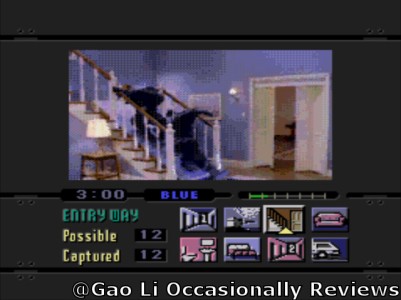
With that in mind, the game isn’t entirely innocent in this controversy. As Howard Lincoln, then CEO Nintendo of America, correctly pointed out in the 1993 hearing: “There was no [age] rating on this game at all when the game was introduced. […] When they [SEGA] started getting heat about this game, then they adopted the rating system and put ratings on it. But today […] you can go into a Toys’R’Us store, or a Walmart, or a K-mart and you know as well as I do that you can buy this product and no one, certainly no sales clerk at retail, is going to challenge you.”4 5 A statement that utterly nullified that of Bill White of SEGA of America, who previously had said that “Sega took a leadership position in establishing an independent rating council and appropriately labeled Night Trap ‘MA17’, not appropriate for children […]”4 5 and who now had to rectify that to “the rating system went into effect in June […] and it was produced with that label on it from that point forward.”4 5

Strangely enough, the copy that I have only has an age rating on the two discs – where it says 15 rather than the claimed 17 – instead of on the outside where customers would see it. However, as I suspect that SEGA of Europe might have had a different age rating than SEGA of America, and because I am uncertain as to whether or not the jewel case’s cellophane wrap had a “15” sticker on it, or if the game came in a box, like CD-ROM based PC video games at the time, I cannot comment on White’s statement about an age rating on the packaging. Despite that, the game’s manual, which was printed in 1993, clearly states that players should “[c]apture anyone or anything that may endanger the guests. DO NOT TRAP THE WOMEN.”7 This exact same statement also shows up in the U.S. version of the manual from before the 1992 (before the hearing)8, but disappeared from subsequent printings for the U.S. market. Instead, newer prints simply tell players to “[u]se the traps as necessary to capture anyone or anything that may endanger the teenagers. Make sure you don’t capture any of the teenagers or members of the S.C.A.T. team.”9
Characters in the game even actively scold players if they fail to save someone, or praise them when one of the girls has been rescued. In several cases, letting a character die even leads to an instant game over screen with Lt. Simms, played by William Jones, telling players to not let them down.
Conclusion
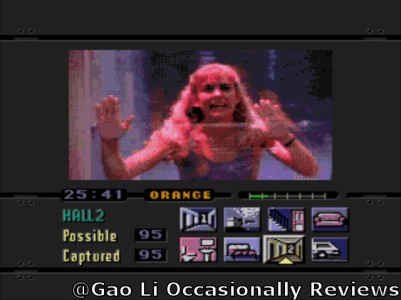
Night Trap is certainly not even half as controversial as it was hyped up to be and its supposed gore has nothing on Mortal Kombat, which came out the same year. (Not to mention later games like Dead Space [2008], Outlast [2013], or even Until Dawn [2015]) While it certainly can scare little children, no teenager would feel frightened by its contents. With that in mind, this video game wanders the fine line between annoying and enjoyable, it is funnoying™, if you will. There are no continues and having to replay the entire game over and over again, just because one didn’t catch enough augers can get really tedious. The game simply struggles to blend film and interactivity together. However, the performances by Dana Plato, Jon Rashad Kamal, together with Christy Ford definitely make it worth checking out and turn Night Trap into a guilty pleasure.
Even those that aren’t into camp and cheese will likely want to check this one out, as the early 1990s saw a flurry of full motion video games (FMV) flooding the market. Developers experimented with the medium and tried to figure out how and if they could turn films into games. Night Trap then has the further advantage that it is that one title that ignited an important discussion about censorship, age ratings, as well as the value and limitations of artistic integrity. And it is good that this discussion took place and continues to take place today.
For those that want to check it out, Night Trap was rereleased for the PlayStation 4 and by Limited Run games on Steam by Screaming Villains for the title’s 25th anniversary and costs $29.99 USD from their storepage. I couldn’t get a copy of it myself, so I don’t know about its quality, but I think it’s good.
Night Trap gets a 7 cheese wheels out of 10 campy special effects
Watch out behind you
Hey there. Thank you for reading my article. If you like, please do feel free to leave a comment. There’s no need to register or login. You can also follow my reviews on Steam: http://store.steampowered.com/curator/8839524-Gaos-Corner/ Like always, all screenshots shown here were taken by me during my playthrough. Have a nice day.
References
- Curtis, Jason, LaserDisc (1983 – 2001), Museum of Obsolete Media, accessed 2017, August 12, retrieved from http://www.obsoletemedia.org/laserdisc/
- Warren, Rich, 1990, December 14, Pioneer`s Cld-980 Combi Laserdisc/cd Player A Bargain, Chicago Tribune, accessed 2017, August 12, retrieved from http://articles.chicagotribune.com/1990-12-14/entertainment/9004130712_1_loading-drawer-laserdisc-player-digital-soundtracks
- ColdFusion, Forgotten Tech | LaserDisc – The DVD of the 1970’s!, YouTube, Alphabet Inc., posted 2016, October 07, accessed 2017, August 12, retrieved from https://www.youtube.com/watch?v=PRFQm0eUvzs
- K. Huntington, congress vs. night trap: 1993, YouTube, Alphabet Inc., posted 2013, June 28, accessed 2017, August 12, retrieved fromhttps://www.youtube.com/watch?v=eJVnL484jbk
- C-SPAN, Video Game Violence, Dec. 9 1993, Cable-Satellite Public Affairs Network, accessed 2017, August 12, retrieved from https://www.c-span.org/video/?52848-1/video-game-violence
- SEGA Enterprises, LTD., 1993, Night Trap (European SEGA Mega-CD) Instruction Manual, page 14, Japan
- SEGA Enterprises, LTD., 1993, Night Trap (European SEGA Mega-CD) Instruction Manual, page 18, Japan
- SEGA of America Inc., 1992, Night Trap (North American SEGA CD) Instruction Manual, page 8, Hayward, California, USA, accessed 2017, August 13, retrieved from https://r.mprd.se/Sega%20CD/Manuals/Night%20Trap%20(U).pdf
- SEGA of America Inc., 1992, Night Trap (North American SEGA CD 32X) Instruction Manual, page 4, San Mateo, California, USA, accessed 2017, August 13, retrieved from http://www.gamesdatabase.org/Media/SYSTEM/Sega_CD/manual/Formated/Night_Trap_-_1992_-_Sega.pdf


great review! I need to remember that funnoying term lol.
LikeLiked by 1 person
Hahahaha, thank you. I came up with the word when I wrote the tweet about the review, originally. Since tweets only have 140 characters, I had to become creative when describing the game. I like that little word. Hope it catches on.
LikeLike
Awesome and Detailed Review
Thank You
LikeLike
Thank you. I tried my best.
LikeLike
Very nicely written and well researched review.
It was really interesting for me to read and get to know some aspects of the early days of video games. ^-^
LikeLiked by 1 person
Thank you. Yeah, I had to spend quite a bit researching this stuff too, because I honestly didn’t know anything about this era when I started playing Night Trap.
LikeLike